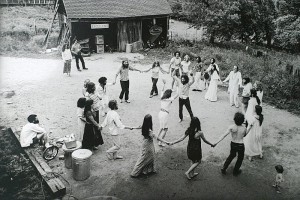 Writing in the weekend’s Wall Street Journal, cuddly atheist Alain de Botton offers up a vision of hell with his proposal for a series of atheist “Agape” restaurants (God help us) at which secular folk could come to share in all the fun of Mass, Seder or the like:
Writing in the weekend’s Wall Street Journal, cuddly atheist Alain de Botton offers up a vision of hell with his proposal for a series of atheist “Agape” restaurants (God help us) at which secular folk could come to share in all the fun of Mass, Seder or the like:
The large number of people who patronize restaurants suggests that they are refuges from anonymity and coldness, but in fact they have no systematic mechanism for introducing patrons to one another, to dispel their mutual suspicions, to break up the clans into which they segregate themselves or to get them to open up their hearts and share their vulnerabilities with others. At a modern restaurant, the focus is on the food and the décor, never on opportunities for extending and deepening affections.
Has the man never been on a date?
But I interrupt:
Patrons tend to leave restaurants much as they entered them, the experience having merely reaffirmed existing tribal divisions. Like so many institutions in the modern city (libraries, nightclubs, coffee shops), restaurants know full well how to bring people into the same space, but they lack any means of encouraging them to make meaningful contact with one another once they are there.
With the benefits of the Mass and the drawbacks of contemporary dining in mind, we can imagine an ideal restaurant of the future, an Agape Restaurant. Such a restaurant would have an open door, a modest entrance fee and an attractively designed interior. In its seating arrangement, the groups and ethnicities into which we commonly segregate ourselves would be broken up; family members and couples would be spaced apart. Everyone would be safe to approach and address, without fear of rebuff or reproach. By simple virtue of being in the space, guests would be signaling—as in a church—their allegiance to a spirit of community and friendship.
Though there wouldn’t be religious imagery on the walls, some kind of art that displayed examples of human vulnerability, whether in relation to physical suffering, poverty, anxiety or romantic discord, would bring more of who we actually are into the public realm, lending to our connections with others a new and candid tenor.
This may just be me, but I suspect that images of “physical suffering, poverty, anxiety or romantic discord” are generally incompatible with a hearty meal for all but psychopaths and sadists, categories of people with whom I never like to dine more than is strictly necessary.
But back to de Botton:
Religions are aware that the moments around the ingestion of food are propitious to moral education. It is as if the imminent prospect of something to eat seduces our normally resistant selves into showing some of the same generosity to others as the table has shown to us. Religions also know enough about our sensory, nonintellectual dimensions to be aware that we cannot be kept on a virtuous track simply through the medium of words. They know that their captive audience is likely to accept a trade-off between ideas and nourishment—and so they turn meals into disguised ethical lessons…
…Taking their seats at an Agape Restaurant, guests would find in front of them guidebooks reminiscent of the Haggadah (the text followed at a Passover Seder) or the Missal, laying out the rules for how to behave at the meal. No one would be left alone to find their way to an interesting conversation with another, any more than it would be expected of participants at a Passover meal or in the Eucharist that they might manage independently to alight on the salient aspects of the history of the tribes of Israel or achieve a sense of communion with God.
The Book of Agape would direct diners to speak to one another for prescribed lengths of time on predefined topics. Like the famous questions that the youngest child at the table is assigned by the Haggadah to ask during the Passover ceremony (“Why is this night different from all other nights?” “Why do we eat unleavened bread and bitter herbs?” and so on), these talking points would be carefully crafted for a specific purpose, to coax guests away from customary expressions of pride (“What do you do?” “Where do your children go to school?”) and toward a more sincere revelation of themselves (“What do you regret?” “Whom can you not forgive?” “What do you fear?”).
The liturgy would inspire charity in the deepest sense, a capacity to respond with complexity and compassion to the existence of our fellow creatures. One would be privy to accounts of fear, guilt, rage, melancholy, unrequited love and infidelity that would generate an impression of our collective insanity and endearing fragility.
As I said, a vision of Hell.

Botton seems like the type who has never in his life wanted to be alone.
A wacky idea, but one that testifies to the fact that within the vast majority of human beings, a religious impulse is hardwired. People will either express that religiosity through traditional forms of religion that have shaped and been shaped by their broader culture, or they will invent new forms of religious ritual — even if they don’t want to call it that. The end of religion won’t happen — just its transformation. If traditional religious faiths die or or get pushed to the margins by the State, religion won’t disappear. If we are lucky, we just get benign and wacky things like these Agape dinners. If we aren’t lucky, we’ll get something much worse. And such worse things do lurk out there, as Marxism and anti-human environmental radicalism evidence.